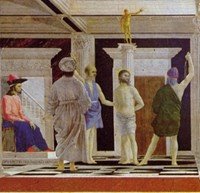Piero della Francesca
Biography of Italian Renaissance Painter,
Pioneer of Linear Perspective.
MAIN A-Z INDEX - A-Z of ARTISTS
|
Piero della Francesca |
 The Flagellation of Christ (1450s) Galleria Nazionale delle Marche, Urbino. One of the most famous examples of Christian art of the Early Italian Renaissance. |
Piero della Francesca (c.1412-1492)Contents • Biography |
|
WORLDS TOP ARTISTS |
Italian Artist Piero della Francesca was one of the most important Old Masters in Early Renaissance art. He was an expert in geometry and mathematics, as well as a leading pioneer of painting techniques such as linear perspective and foreshortening. Almost all his painting was religious art, being mostly altarpieces or mural paintings for churches. His own particular brand of Renaissance art was characterized by his mathematically precise construction of spatial 'depth', together with the three-dimensional modelling of his figures. In addition to his mastery of both tempera and fresco painting, he developed an innovative glazing method that increased the atmospheric effect of his pictures. His greatest masterpiece is The Flagellation of Christ (1450s, Galleria Nazionale delle Marche in Urbino), considered by the art critic Kenneth Clark to be one of the greatest religious paintings ever seen. Other important examples of his early Renaissance painting include: the double portrait of Federigo da Montefeltro and his wife (1465, Uffizi, Florence) and the fresco cycle known as The Legend of the True Cross (1452, Church of San Francesco in Arezzo, Tuscany). Forgotten for centuries after his death, Piero della Francesca is now seen as one of the key Early Renaissance artists, who had a major influence on the development of the Italian Renaissance during the late 15th century. |
|
WORLD'S BEST ART RELIGIOUS HISTORY
PAINTING COLOURS USED IN
PAINTING WORLD ART PRICES |
 |
Little is known of his early life, but it is assumed he was born in a small town, Sansepolcro, in the Tuscany region, some time between 1400 and 1420. His father was a tradesman and shoemaker and it is assumed that the young Francesca received an education. He may have been apprenticed to several artists, but it is known for certain that he was apprenticed in Florence to Domenico Veneziano (1410-61), who himself may have been a former pupil of Gentile da Fabriano (1370-1427). Francesca worked with Veneziano on several frescoes for the church of the Santa Maria Nuova hospital. Sadly, these works are now lost. During this time he was introduced to other famous painters of the 15th-century quattrocento, including Fra Angelico (1400-55), Masaccio (1401-1428) and the architect Filippo Brunelleschi. In 1442, Piero della Francesca returned to his hometown where he received the commission for a work of altarpiece art at the church of Misericordi, which took him nearly 20 years to complete. In 1449 he painted several frescos at the Sant'Andrea of Ferrara and the Castello Estense, both now unfortunately lost. Two years later he painted his most famous fresco, the Sigismondo Pandolfo Malatesta Praying in Front of St. Sigismund, in addition to the Condottiero. It was around this time he was introduced to the famous early Renaissance architect, artist, mathematician and humanist Leon Battista Alberti. |
|
|
|
|
Francesca wrote complex works about geometry and perspective, which survive to this day: Abacus Treatise (Trattato d'Abaco), On Perspective for Painting (De Prospectiva Pingendi), and Short Book on the Five Regular Solids (Libellus de Quinque Corporibus Regularibus). These writings were later absorbed and developed by others including the Italian mathematician Luca Pacioli, who wrote De Divina Proportione (which was illustrated by Leonardo da Vinci). Many of Francesca's mathematical studies influenced his own paintings. He liked to organise his composition in a pattern, which suggested an underlying geometric scheme and advanced understanding of perspective. His colour palette was generally quite light, and often painted large areas in white or off-white. He painted large sunny skies and his pictures were relatively clutter-free. Although at the time some thought this gave his works an 'unfinished' appearance, his fresh approach gained appreciation in later years. The Legend of the True Cross Fresco Cycle The Legend of the True Cross, a cycle of frescoes, is generally considered his masterwork. (The True Cross is the name for the physical remains of the cross, upon which it is believed Jesus was crucified. Several churches claim to possess parts of these remains, although their authentity is impossible to verify.) This work is housed at the The Basilica of San Francesco, a church in Arezzo, Tuscany. He was commissioned by the Vatican for several pieces, many of which have been destroyed or only fragments remain, including frescoes at the Basilica di Santa Maria Maggiore and Vatican Palace. In about 1460 he painted The Flagellation, one of his most famous, yet controversial works. The composition is unusual and complex. Three figures stand in the foreground chatting, apparently completely unaware that Christ is being flagellated by the Romans in the background. The picture contains strong lines and form. In fact, it was highly admired by Cubist painters and abstract artists centuries later, and the art historian Sir Kenneth Clark described it as 'the greatest small oil painting in the world'. |
|
|
Other notable works include The Baptism
of Fire, c.1450 (National Gallery, London); The Resurrection,
c.1463 (Palazzo Communale of Borgo, Sansepolcro, Tuscany); diptych
Portraits of Federico da Montefeltro, Duke of Urbino, and His Wife,
Batista Sforza, c.1465 (Galleria degli Uffizi, Florence); In later years he stopped painting - preferring to pursue other interests like writing. However, according to Giorgio Vasari, the celebrated chronicler of the Italian Renaissance, Francesca went blind in his old age. He died on July 5th, 1492, the same day that Christopher Columbus discovered America. Certain elements of Francesca's painting exerted significant influence over other Renaissance artists, including Melozzo da Forli (1438-94), celebrated for his Ascension of Christ fresco (1478-80) in the church of the Holy Apostles, Rome; Andrea Mantegna (famous for the foreshortening technique as shown in his Lamentation over the Dead Christ); and Giovanni Bellini in Venice. In general, however, Francesca's work was too individualistic to influence mainstream Renaissance art to any great extent.
|
|
• For more information about Renaissance painters, see: Homepage. Visual
Artists, Greatest |